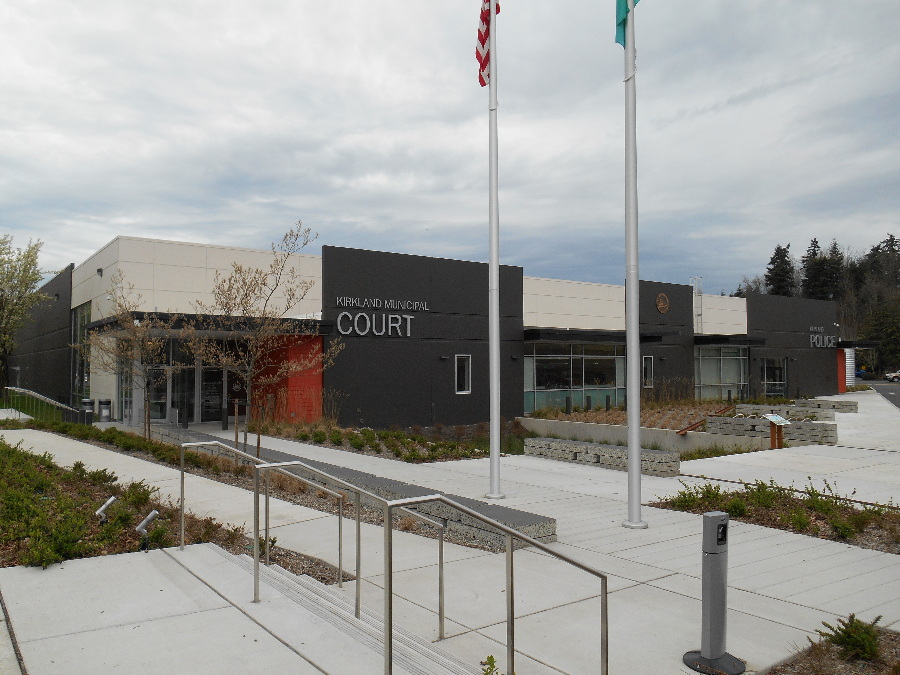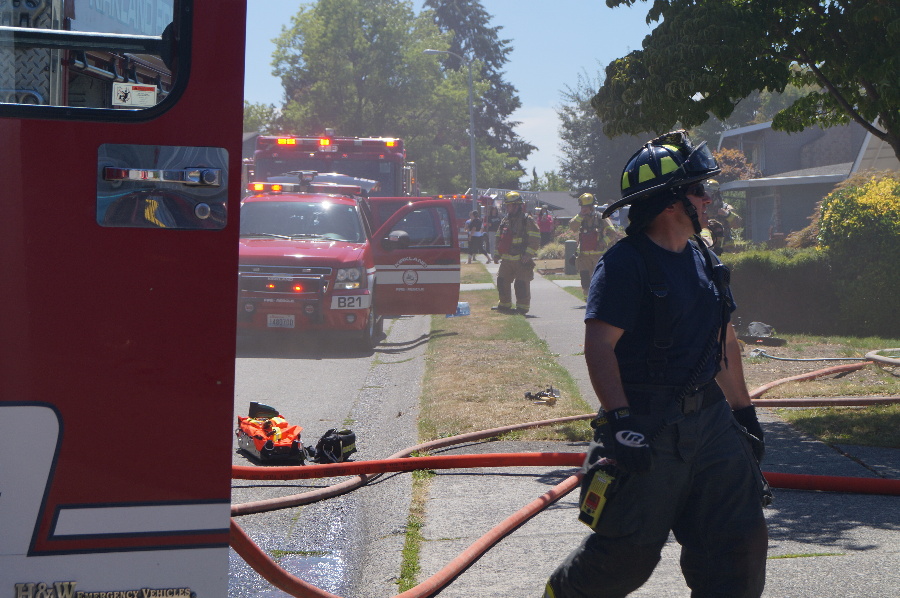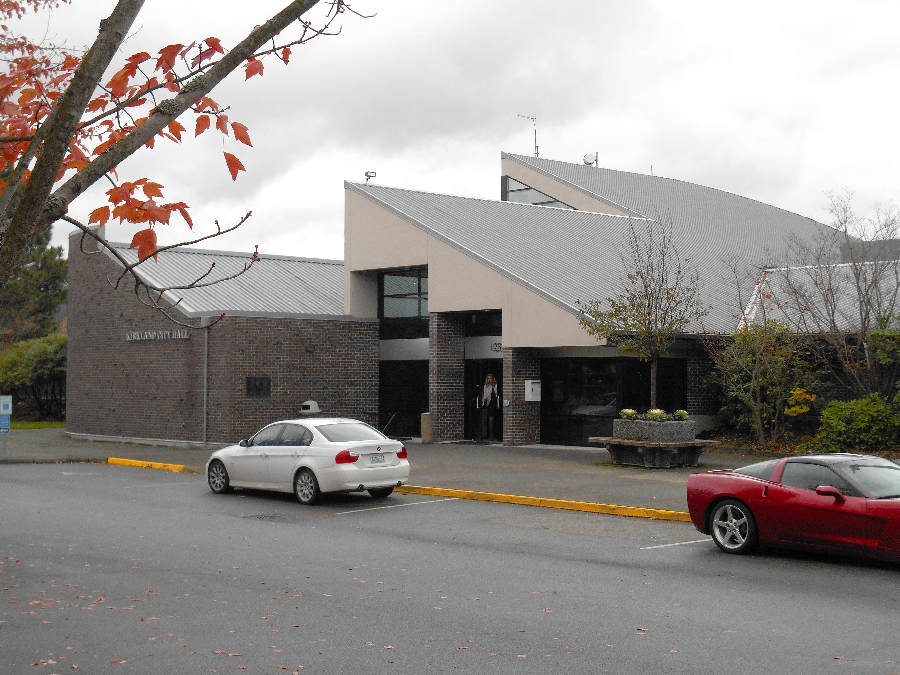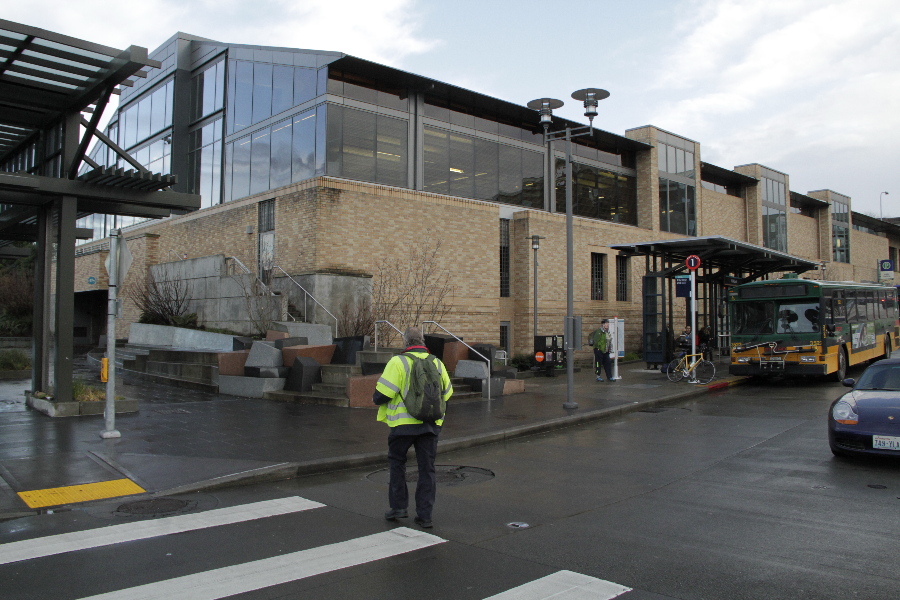C. Public Services Goals and Policies
|
Goal PS-1: Provide fire protection, emergency medical services, emergency management, and police service to the community through a cost-effective and efficient delivery system to maintain a safe environment for the public. |
|
Goal PS-2: Provide efficient and convenient solid waste and recycling services to the community through coordination with service providers and the local solid waste management agency. |
|
Goal PS-3: Maintain the quality of life in Kirkland through the planned provision of regional services in coordination with other public service providers. |
City-Managed Public Services
One of the advantages of living in an urban setting such as Kirkland is a level of emergency service and solid waste collection that exceeds the level of service commonly found in rural areas. To maintain the emergency services, Kirkland must be prepared for new expenditures while finding additional system efficiencies. To maintain the solid waste and recycling collection service levels, Kirkland must coordinate with collection service providers and the King County Solid Waste Management Division.
Fire, Police, Emergency Medical Services and Emergency Management
Goal PS-1: Provide fire protection, emergency medical services, emergency management, and police service to the community through a cost-effective and efficient delivery system to maintain a safe environment for the public.
Criminal Justice Center in Totem Lake Neighborhood
Policy PS-1.1: Provide fire, emergency medical services and police services to the public which maintain accepted standards as new development occurs.
Basic public safety service should keep pace with growth. Kirkland should anticipate new growth to avoid deficiencies in accepted levels of service.
Policy PS-1.2: The adopted levels of service for fire and emergency medical services are as follows:
♦ Emergency medical: response time of five minutes to 90 percent of emergency incidents.
♦ Fire suppression: response time of 5.5 minutes to 90 percent of all fire incidents.
The emergency medical and fire suppression response times are accepted standards for two principal reasons. For fire response times, it sets a threshold to minimize property loss and reduce the level of risk to response teams. For emergency medical service, the response time has a direct link to human physiology and resuscitation.
Response times are influenced by various factors such as locations of resources, accessibility, and available personnel. Kirkland must balance all of these factors in prioritizing the commitment of resources. The established levels of service for response times in underserved portions of the City will require funding a variety of street improvements, either an increase of the number or relocation of fire stations and consideration of increased response personnel. Figures PS-1 and PS-2 indicate where there are deficiencies. The City is currently studying improvement opportunities that can be implemented as funding becomes available.
Fire trucks in action
Policy PS-1.3: Provide a system of streets that facilitates improved emergency response times.
This policy suggests a philosophy of through-street connections allowing for multiple emergency access routes. Where feasible, dead-end streets and cul-de- sacs should be avoided. For the most part, Kirkland is served by interconnected streets but there are exceptions. Interstate 405 presents a significant barrier to east-west travel. New access routes should be explored to areas of the City that have poor emergency access and inferior emergency response times. Traffic calming programs and devices should be designed to balance the needs of the neighborhood and the need to maintain emergency response time levels of service.
Policy PS-1.4: Develop and maintain a water system that provides adequate fire flow for anticipated development based on land use designations of the Comprehensive Plan.
This policy is intended to ensure that an adequate water supply and pressure is available for new and existing development. Kirkland should periodically review the system to identify existing and potential fire flow deficiencies and continue to employ a variety of methods to correct those deficiencies.
Policy PS-1.5: Provide a robust training and exercise program in emergency management response operations for City employees.
City employees are responsible for moving from their everyday positions into similar emergency management response operations positions at the onset of an incident. As such, this policy ensures Kirkland will provide updated training that is exercised at least twice a year, maintaining a high quality skill base for response operations during a disaster.
Policy PS-1.6: Maintain accessible disaster plans that incorporate a whole community approach to emergency management for all hazards.
This approach to emergency management identifies that planning must incorporate the whole community to be effective including: individuals, families, businesses, City of Kirkland, community-based organizations, faith-based organizations, voluntary organizations, neighborhood associations, people with access and functional needs, children, school systems, elders, and private-sector partnerships.
Policy PS-1.7: Sustain a disaster response system that incorporates local, state, tribal, and federal partners to facilitate enhanced disaster readiness, response, recovery, and resilience.
This policy acknowledges that emergency management and disaster response is regionally based because incidents do not respect artificially imposed borders. Maintaining strong relationships through planning, training, and exercise partnerships with all disaster related government agencies will help the Kirkland community respond and recover from a disaster.
Policy PS-1.8: Ensure that safety and security considerations are factored into the review of development proposals.
Kirkland has a history of thorough review of new development proposals at an early stage to ensure that fire, emergency management, police and building safety concerns are factored in.
Policy PS-1.9: Ensure compatibility in scale and design with surrounding uses by reviewing new public facilities for compliance with adopted urban design principles.
Kirkland City Hall
The design of City facilities should accurately reflect the City’s philosophy. For example, City Hall has been designed to reflect the scale of the residential neighborhood to the north, while providing territorial views from within. The Justice Center, completed in 2014, reused an existing building, and incorporated many green building techniques and public art in its remodel. Other facilities, like fire stations, should be responsive to the scale and other qualities of the residential neighborhoods in which they are located. Public art should be incorporated to improve the aesthetics, whether as an integral part of the architecture, through landscaping or by applying other techniques.
Policy PS-1.10: Update Fire, Emergency Management, and Police functional plans at appropriate intervals to incorporate and remain consistent with the goals, policies, and land use projections of the Comprehensive Plan.
All of the City’s planning documents should be based on consistent and accurate assumptions. The Comprehensive Plan should be updated as necessary to reflect any changes in those assumptions.
Solid Waste Collection
Goal PS-2: Provide efficient and convenient solid waste and recycling services to the community through coordination with service providers and the local solid waste management agency.
Policy PS-2.1: Coordinate with the City’s solid waste and recycling collection contractors and King County Solid Waste Division to ensure that the existing level of service standards are maintained or improved and waste reduction and recycling goals and targets are in compliance with the Draft 2013 King County Comprehensive Solid Waste Management Plan (SWMP) update.
The SWMP establishes Countywide waste reduction and recycling goals for single-family residential, multifamily residential and commercial sectors to be achieved by 2020. Cities adopting the Comprehensive Plan commit to implementing and/or maintaining waste reduction and recycling programs and collection standards to support the overall goals and targets identified in the SWMP.
The SWMP waste reduction and recycling goals are aligned with adopted King County-Cities Climate Collaboration (K4C) 2014 Joint County-City Climate Commitments. The K4C is a partnership between County and cities to coordinate and enhance local government climate and sustainability efforts.
The SWMP level of service goals for solid waste collection and recycling are summarized below.
Waste Prevention – This goal addresses all types of waste: yard waste, recycling and garbage. By looking at overall waste generation of all kinds (tons of material disposed plus tons recycled), trends in waste prevention activity can be identified. A decline means that the overall amount of materials alone or combined has been reduced. Waste generation rates to be achieved by 2020 are: 20.4 pounds/week per person from single-family and multifamily homes; and 58 pounds/week per employee from the nonresidential sector.
Waste Disposal – This goal addresses only garbage disposed in landfills. Reductions in disposal over time indicate an increase in waste prevention and/or recycling. Waste disposal rates to be achieved by 2020 are 14.2 pounds/week per person from single and multifamily homes and 22.9 pounds/week per employee from the nonresidential sector.
Recycling – Recycling will continue to be an important strategy to reduce the disposal of solid waste. The recycling goal combines single-family, multifamily, nonresidential and self-haul recycling activity. The overall recycling rate goal by 2015 is 55 percent. The overall recycling goal by 2020 is 70 percent. The K4C 2914 Climate Commitments target the achievement of zero waste of resources that have value for reuse, resale and recycling by 2030.
Reducing waste and achieving a high recycling diversion rate reduces the amount of garbage going to the Cedar Hills Landfill, which in turn extends the time before the landfill reaches capacity and other solutions must be found for disposing of King County’s solid waste. Waste reduction and recycling programs throughout King County have extended the life of the Cedar Hills Landfill through at least 2026. In addition, recycling reduces the need to produce more raw materials for certain plastics, paper and aluminum.
Policy PS-2.2: Encourage reduction, reuse and recycling of building construction materials in order to reduce waste, increase diversion, and save energy.
Encouraging the construction industry to salvage, reuse and/or recycle construction, demolition, and land clearing debris supports the City’s role as an environmental steward. Various City incentives to meet this objective are geared toward the development community by encouraging the practice of salvaging and reusing building materials, separating recyclable from non-recyclable materials on the jobsite and construction techniques that use fewer materials than conventional methods. The City’s Green Building Program uses several certification programs that ensure that the building construction material waste stream is reduced.
City projects and private development should provide a plan with their permit applications that describe how the building materials will be salvaged, reused or recycled. The City’s participation in regional collaborations to help create the local infrastructure for salvaging, reuse and recycling of these valuable resources will be essential to making this transition a success. Over time these techniques or programs may become mandatory.
Non-City-Managed Public Services – Schools, Libraries and Solid Waste Transfer
The provision of quality public facilities and services has traditionally been a tangible measure of a community’s quality of life. Excellent schools and libraries with convenient access are indicative of a community that cares about its future.
Although the City does not operate these services, the City does have an influence on facility planning and development by its authority to regulate land uses and the requirement to adopt a comprehensive plan. In addition, the Growth Management Act requires Kirkland to demonstrate that all capital facilities serving the City have been considered and that planning is done in a coordinated and comprehensive fashion.
Goal PS-3: Maintain the quality of life in Kirkland through the planned provision of regional services in coordination with other public service providers.
Policy PS-3.1: Coordinate with King County Solid Waste Division to ensure that the Houghton Transfer Station is closed by 2021 and in the interim that established levels of service for solid waste disposal and transfer are followed and impacts are mitigated.
The City should work with King County to ensure the station is closed on or before 2021 and that the County implement and/or maintain mitigation measures to improve pedestrian and hauler safety and to reduce impacts of noise, odor and number of large trucks coming to the site until the transfer station is eventually closed.
Resolution R-5001 and Position Statement adopted on September 17, 2013, and Resolution R-5031 and Letter adopted on February 4, 2014, reflecting the City’s policy position to endorse a 2021 closure, define Kirkland’s position.
Policy PS-3.2: Coordinate with regional service providers to maintain appropriate levels of service, review funding alternatives, and coordinate construction of shared public facilities.
This policy contemplates a channel of communication between the City and the service providers to ensure shared responsibility for meeting the needs of Kirkland residents. As required by Growth Management the City shares its growth forecasts, targets and capacity information with regional service providers.
Policy PS-3.3: Ensure compatibility in scale and design of the new facilities with surrounding uses by reviewing for compliance with adopted urban design principles.
Facilities are spread throughout the community in residential and commercial areas. The Kirkland resource library is located downtown and the design and scale is appropriate for that environment. The Kingsgate Library remodel also reflects the community character of that neighborhood. Most school facilities are located in residential areas and the design and scale should likewise reflect a residential environment.
Library
Policy PS-3.4: Coordinate with neighboring cities, King County, the Lake Washington School District, special districts and other agencies in the planning, provision, and use of joint activities and facilities.
The City should look for these types of opportunities in order to make efficient use of existing facilities and save on the costs of building new facilities or funding new programs. Joint use and maintenance of school athletic fields and facilities for community programs are examples.
Policy PS-3.5: Assess appropriate school impact fees to help offset the cost of financing new school public services infrastructure serving new development.
State law permits cities to assess impact fees on new residential development for facilities provided by the Lake Washington School District. Impact fees may be collected and spent only on specific publicly owned capital facilities. These capital improvements are identified in the Lake Washington School District’s Capital Facilities Plan and are designed to provide facility capacity and service to areas within the community at large.
Policy PS-3.6: Coordinate with the Lake Washington School District on the planning, siting and development of new, replaced or expanded school facilities.
The City and Lake Washington School District should work together on planning for school facilities consistent with the City’s Comprehensive Plan. This could mean using consistent data on population and demographics based on the City’s growth and development projections. The City and School District should confer on the siting and development of school facilities needed to serve existing and projected residential development, as well as the City’s development regulations and impacts to other public services and facilities. The City and School District should explore opportunities for jointly developing and maintaining school sites to maximize community use. The School District should provide safe pedestrian and bicycle access to connect schools to the surrounding neighborhood when new or expanded schools are proposed. The City should establish a system of school walk routes. With the development of new or expanded schools, the District should ensure appropriate public involvement.
Policy PS-3.7: Commit resources to public services and infrastructure for underserved populations.
Strategically target areas where there are identified deficiencies. Good schools and library, police, fire, emergency management and garbage service access should be available to economically disadvantaged populations, including minorities and women, throughout the City.
Policy PS-3.8: Ensure all public services and facilities are accessible to people with disabilities.
The City is drafting an Americans with Disabilities Act (ADA) Transition Plan which will address the status of the City’s facilities and programs for ADA compliance. Once completed, the City will consider funding necessary for ADA improvements in a manner consistent with the timely implementation of this policy.






